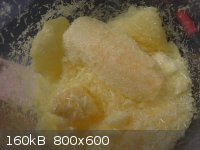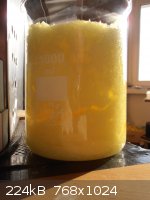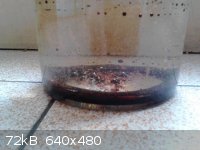gordonL
Harmless

Posts: 8
Registered: 29-7-2013
Member Is Offline
Mood: No Mood
|
|
Need help about Nitrostyrene synthesis
Hello want some help about Nitrostyrene synthesis
I'm trying to synthese Nitrostyrene by this method
100 ml benzaldehyde + 200 Nitromethane + 20 gr. ammonium acetate + 50-60 ml. glacial acetic acid
refluxed on water bath for 5 hours on 70 degrees
the mixture have verry dark color like a dark caramel
after that I put 180 ml warm water
but nothing happens, no yellow crystals - nothing, just two layers
What could be the problem?
Thanks
|
|
|
DrSchnufflez
Hazard to Others
  
Posts: 114
Registered: 22-1-2013
Location: Australia
Member Is Offline
Mood: No Mood
|
|
The nitrostyrene is most likely dissolved in the excess nitromethane.
Have you tried evaporating/ distil long off the excess nitromethane?
‘I’m free and easy-I’ll see you there!’
- Our Sunshine, Paul Kelly
|
|
|
gordonL
Harmless

Posts: 8
Registered: 29-7-2013
Member Is Offline
Mood: No Mood
|
|
Quote: Originally posted by DrSchnufflez  | The nitrostyrene is most likely dissolved in the excess nitromethane.
Have you tried evaporating/ distil long off the excess nitromethane? |
Nope. I don't
what should be the ratio between benzaldehyde and nitromethane? 1:1? And one more thing. Do I have to use acetec acid?
|
|
|
bfesser
Resident Wikipedian
    
Posts: 2114
Registered: 29-1-2008
Member Is Offline
Mood: No Mood
|
|
Why are you not following the <em>Org. Syn.</em> <a href="http://www.orgsyn.org/orgsyn/orgsyn/prepContent.asp?prep=cv1p0413"
target="_blank">procedure</a> <img src="../scipics/_ext.png" />‽
|
|
|
gordonL
Harmless

Posts: 8
Registered: 29-7-2013
Member Is Offline
Mood: No Mood
|
|
Quote: Originally posted by bfesser  | | Why are you not following the <em>Org. Syn.</em> <a href="http://www.orgsyn.org/orgsyn/orgsyn/prepContent.asp?prep=cv1p0413"
target="_blank">procedure</a> <img src="../scipics/_ext.png" />‽ |
hot synthese is easier for me.
[Edited on 29-7-2013 by gordonL]
|
|
|
solo
International Hazard
    
Posts: 3966
Registered: 9-12-2002
Location: Estados Unidos de La Republica Mexicana
Member Is Offline
Mood: ....getting old and drowning in a sea of knowledge
|
|
...did you try a google search,....solo
https://www.google.com.mx/search?q=preparation+of+nitrostyre... fficial&client=firefox-a&gws_rd=cr fficial&client=firefox-a&gws_rd=cr
.....here is an interesting one....,
http://www.erowid.org/archive/rhodium/chemistry/nitrostyrene...
[Edited on 29-7-2013 by solo]
It's better to die on your feet, than live on your knees....Emiliano Zapata.
|
|
|
bfesser
|
Thread Moved
29-7-2013 at 13:01 |
gordonL
Harmless

Posts: 8
Registered: 29-7-2013
Member Is Offline
Mood: No Mood
|
|
All the same 
0.22 mol Nitromethane, 20 mol Benzaldehyde, ammonium acetate 7.8 gr., 50 ml GAA
here's the result mixed with 1l. ice cold water
http://anonym.to/?http://i.imgur.com/qCngB3X.jpg
|
|
|
Organikum
resurrected
    
Posts: 2329
Registered: 12-10-2002
Location: Europe
Member Is Offline
Mood: busy and in love
|
|
Yep, the acetic acid fucks it up.
Ammonium actate is not a very good catalyst for its not active enough and so requirers to high temperatures. Also it tends to form byproducts which
cannot be removed easily going throgh a lot of possible following reactions.
Basically any primary amine will do the job though. Some of them are available OTC in common products IIRC.
An example:
10ml benzaldehyde are added whilst stirring to 11ml nitromethane or nitroethane (both reacts the same) in the cold which contains 2ml cyclohexylamine
which was neutralized by GAA until acidic (Can be done best in the nitromethane as solvent - slowly, stirring, cold).
Thats rapidly heated to about 65°C in a microwave or an oilbath until slight discoloration occurs, then its put aside to cool down to RT (color gets
more intense) and then in the fridge for some hours. Scratching with a glassrod or so you have much better some seed crystals induce crystallisation
(It mostly crystallized already just so, or when taken out of the fridge, a nice view!). Back in the fridge for an hour and then filtered at the pump
(preferably, gravity filtration will do but get an aspirator, really). The filtercake is washed down with a small amount of ice-cold alcohol (EtOH,
IPA...), this adds to the soup and then....
Then the heating - cooling - crystallisation etc. cycle is repeated two times more (it gets darker each time - no problem) and maybe even a third
time.
Overall one ends up with beautiful crystals which usually are perfect after just a waterwash (must do! removes catalyst). Recrystallisation from IPA
makes it even better. The first 2 goes are best of course.
Yields are excellent.
And I really mean it.
Less is more. Water does not interfere. Boiling is polymerisation madness. The formation of the styrene is hindered by styrene, is this removed it ges
on and on and on.....
To prove I am not sucking this from my fingertips....
 
[Edited on 31-7-2013 by Organikum]
|
|
|
gordonL
Harmless

Posts: 8
Registered: 29-7-2013
Member Is Offline
Mood: No Mood
|
|
Organikum, I thik you're right. I should try with some amine - cyclohexylamine, butylamine, propylamine.
Just one more question. Approximately how much GAA you use?
|
|
|
batsman
Harmless

Posts: 36
Registered: 4-7-2013
Member Is Offline
Mood: No Mood
|
|
I am reading Pihkal, and in it there are many many different compounds, (nitrostyrene, nitroethane among others) that he have written without any
directions on how to make them. At least not that i have found yet.
One thing that i like is that Shulgin have synthesis explaination on the making on a small yields. Some are as little as 0,5 g, maybe less. I don´t
mean that his reactions are bad, just that he make small amounts each time. But if one would want to scale up on one of his recipes, and make 1 gram
instead. Is it possible to just double the amounts of compounds from the start, for example? Or do i mess up the mole counting then?
The orgsyn.org link was really cool. I have been wondering about the nitrostyrene recipe.
I couldn´t find anything on nitroethane. Which synth is the best, and easiest to do in order to yield nitroethane?
|
|
|
Organikum
resurrected
    
Posts: 2329
Registered: 12-10-2002
Location: Europe
Member Is Offline
Mood: busy and in love
|
|
Quote: Originally posted by gordonL  | Organikum, I thik you're right. I should try with some amine - cyclohexylamine, butylamine, propylamine.
Just one more question. Approximately how much GAA you use? |
As an example:
10ml B-dehyde + 11ml Nitro + 2ml cyclo + 1,6ml GAA
Can be used for nitromethane and ethane, the different density compensated by the molecular weight.
@ Batsman: Shulgin is great but not all methods he uses are great. His nitrocondensations are an example for this. I know he would have not the
slightest problem admitting this and congratulating everybody who found something better. He is a great man. I very much hope I am not the only one
here to donate for his care now after his stroke.
Sensitive compounds can be prepared with benzoic acid instead acetic acid. Works very well from what I know.
The linked OrgSyn works btw. really good for ancient stuff. Better then sodium actate.
You can scale up from 0,5g to 1g without issues, thats in range. Scaling up from 1mmol to 1 mol is something completely different though.
The by me described method was tested from 5g to 300g and works in this range guaranteed. I woould not go bigger but use more flasks instead, say
3x300g Erlenmeyers instead of 1x1000g, put them together in the micro or oilbath with some distance, its on the heattransfer.
/ORG
[Edited on 31-7-2013 by Organikum]
|
|
|
bfesser
Resident Wikipedian
    
Posts: 2114
Registered: 29-1-2008
Member Is Offline
Mood: No Mood
|
|
Well, of course the <em>Org. Syn.</em> procedure works. The journal publishes established and tested procedures, only. It's often the
first place I look, and why I shared the link.  <a
href="http://www.orgsyn.org/" target="_blank"> <a
href="http://www.orgsyn.org/" target="_blank"> | Quote: | <div align="center"><img src="http://www.orgsyn.org/Organic%20Syntheses%20Website_files/oslogo_withwords.gif" width="350" /></div>
Since 1921, <em>Organic Syntheses</em> has provided the chemistry community with detailed, reliable, and carefully checked procedures for
the synthesis of organic compounds. Some procedures describe practical methods for the preparation of specific compounds of interest, while other
procedures illustrate important synthetic methods with general utility. Each procedure is written in considerably more detail as compared to typical
experimental procedures in other journals, and each reaction and all characterization data has been carefully "checked" for reproducibility in the
laboratory of a member of the Board of Editors. <img src="../scipics/_ext.png" /> |
</a>
|
|
|
gordonL
Harmless

Posts: 8
Registered: 29-7-2013
Member Is Offline
Mood: No Mood
|
|
:(
Even with cyclo, result is the same 

|
|
|
Organikum
resurrected
    
Posts: 2329
Registered: 12-10-2002
Location: Europe
Member Is Offline
Mood: busy and in love
|
|
Without details on ratios and temperatures and what was used in which amoiunts in what order, fuck what do you expect? Brainreading?
I suspect you are still boiling the holy shit outa it or using masses of acid.
Probably both.
The very most OrgSyn recipes work.
Does not say thats the best way to do it. Some water has run down the rivers since 1925.
Hey janitor, shouldn´t you be supervising the cleansing of the restrooms at the moment?
Cats away, mice dancing on the table.....
/ORG
[Edited on 25-8-2013 by Organikum]
|
|
|
gordonL
Harmless

Posts: 8
Registered: 29-7-2013
Member Is Offline
Mood: No Mood
|
|
Quote: Originally posted by Organikum  | Without details on ratios and temperatures and what was used in which amoiunts in what order, fuck what do you expect? Brainreading?
I suspect you are still boiling the holy shit outa it or using masses of acid.
Probably both.
The very most OrgSyn recipes work.
Does not say thats the best way to do it. Some water has run down the rivers since 1925.
Hey janitor, shouldn´t you be supervising the cleansing of the restrooms at the moment?
Cats away, mice dancing on the table.....
/ORG
[Edited on 25-8-2013 by Organikum] |
hey hey, calm down 
I used your proportions 22 ml nitromethane, 20 ml benzaldehyde, 4 ml cyclo and 3.2 ml GAA in this order
I didnt put it on microwave, but on reflux for 1 hour @ 85 degrees
|
|
|
starman
Hazard to Others
  
Posts: 318
Registered: 5-7-2008
Location: Western Australia
Member Is Offline
Mood: No Mood
|
|
Well if you were expecting a crystalline product and it oiled out on you. Have you read anything on laboratory technique?
Jeez.Direct recystallisation maybe? Methanol,ethanol or isopropanol possibly suitable.
Chemistry- The journey from the end of physics to the beginning of life.(starman)
|
|
|
organichem
Harmless

Posts: 19
Registered: 18-9-2013
Member Is Offline
Mood: No Mood
|
|
Well, I found a very interesting/promising article - but I've no access to it:
Ambiphilic Dual Activation Role of a Task-Specific Ionic Liquid: 2-Hydroxyethylammonium Formate as a Recyclable Promoter and Medium for the Green
Synthesis of β-Nitrostyrenes
Some abstract can be found on organic-chemistry.org
|
|
|
Agricola
Harmless

Posts: 42
Registered: 28-10-2013
Location: Brazil
Member Is Offline
Mood: No Mood
|
|
The paper is attached to this message.
Attachment: nitrostyrenes_alizadeh2010.pdf (1MB)
This file has been downloaded 1012 times
|
|
|
Organikum
resurrected
    
Posts: 2329
Registered: 12-10-2002
Location: Europe
Member Is Offline
Mood: busy and in love
|
|
Quote: Originally posted by gordonL  | Quote: Originally posted by Organikum  | Without details on ratios and temperatures and what was used in which amoiunts in what order, fuck what do you expect? Brainreading?
I suspect you are still boiling the holy shit outa it or using masses of acid.
Probably both.
The very most OrgSyn recipes work.
Does not say thats the best way to do it. Some water has run down the rivers since 1925.
Hey janitor, shouldn´t you be supervising the cleansing of the restrooms at the moment?
Cats away, mice dancing on the table.....
/ORG
[Edited on 25-8-2013 by Organikum] |
hey hey, calm down 
I used your proportions 22 ml nitromethane, 20 ml benzaldehyde, 4 ml cyclo and 3.2 ml GAA in this order
I didnt put it on microwave, but on reflux for 1 hour @ 85 degrees
|
To long to hot as said.
Hit it in the sep-funnel with ice-cold brine.
Either it crashes out or if not separate and then it will.
/ORG
|
|
|
chemrox
International Hazard
    
Posts: 2961
Registered: 18-1-2007
Location: UTM
Member Is Offline
Mood: LaGrangian
|
|
I wonder what's going on? I would suggest some practice with less spendy reagents.. just general practice. Anyway I really appreciate the 2HEMF
article. I found a prep for it. Or is it 2-HEAF?
Attachment: HEMF_prep.pdf (152kB)
This file has been downloaded 1042 times
[Edited on 15-11-2013 by chemrox]
"When you let the dumbasses vote you end up with populism followed by autocracy and getting back is a bitch." Plato (sort of)
|
|
|
Organikum
resurrected
    
Posts: 2329
Registered: 12-10-2002
Location: Europe
Member Is Offline
Mood: busy and in love
|
|
They are of course just naming prior art which makes their method look good. Albeit its not god at all. 2-HEAF to substrate is >5 to 1, thats not a
catalyst - thats a solvent with additional properties.
I propose that th ionic liquid character is just not essential and that for example the acetate instead the formate will work the same if not better,
the benzoate will do it also, and if one zaps the whole shebang in the microwave (short) then an ctalytic amount will suffice, say something like 3 to
10 (g or ml just by thumb) and not the insane amount which is used by the authors of the article, which is one of the shady sort which makes me think
of lighters and testicles. But there is far worse around nowadays.
@Chemrox: Right, such an easy ionic liquid might come very handy, have not seen something like this up to now. Not stable anough for many interesting
uses though, I am afraid, but there might be some gold to discover nevertheless.
/ORG
|
|
|
organichem
Harmless

Posts: 19
Registered: 18-9-2013
Member Is Offline
Mood: No Mood
|
|
I was curious if it would work and tried the HEAF-method on a 10 mmol-scale, using anisaldehyde and nitroethane.
My scale has only an accuracy of 0.1 g - so it is definitely just a "over-the-thumb"-method in this 10 mmol range.
I took 1.3 g of anisaldehyde and 0.7 g of nitroethane, mixed it in a small beaker, added approx. 10 mL HEAF and stirred it vigorously on the magnetig
stirrer for 70 min. Afterwards I added water to about 50 mL total volume, causing a yellowish precipitate, floating partially on the top - vacuum
filtered it, and recrystallized from ca. 5 mL of MeOH.
Filtration yielded 1.4 g of the nitrostyrene corresponding to about 78 %.
Scaling it up and being more accurat could be more efficient though.
[EDIT: little error - it was 2 h 10 min, not only 1 h 10 min]
[Edited on 16-11-2013 by organichem]
|
|
|
organichem
Harmless

Posts: 19
Registered: 18-9-2013
Member Is Offline
Mood: No Mood
|
|
Small-scale trial of the Henry-Reaction with 2-HEAF (~10 mmol)
1.3 g anisaldehyde (MW 136, ~9.6 mmol)
0.7 g EtNO2 (MW 75.07, ~9.3 mmol)
10 mLs 2-HEAF
In a 50 mL beaker together with a small magnetig stirbar was added 1.3 g anisaldehyde as well as 0.7 g nitroethane and thereto added 10 mLs of
2-hydroxyethyl ammonium formate The mixture was vigorously stirred and a watchglass placed upon the top of the beaker to prevent squirting. The medium
was stirred for 2 h 10 min before the content was diluted to 50 mLs with water. The nitroalkene precipitated was vacuum filtered, washed wit 2 x 25
mLs of water, sucked dry and recrystallized using a little MeOH (about 5 mL). The final product weighed 1.4 g (~7.3 mmol) – ~78 % yield.
Up-scaling the Henry-reaction with 2-HEAF (70 mmol)
10.5 g piperonal (MW 150, 70 mmol)
5.3 g / 5.0 mLs EtNO2 (MW 75, 70 mmol)
70 mL 2-HEAF
The reaction was carried out as described in the 10 mmol-scale reaction despite a 250 mL beaker was used, the time reduced to 90 min and the aldehyde
and NE were added to the preheated IL (about 50 °C, to liquefy the solid aldehyde and improve stirring, letting it cool over the reaction time). The
IL-filtrate was saved for recycling.
11.6 g (56 mmol) recrystallized nitroalkene – 80 % yield (did not reduce the volume of the mother liquor from the recrystallization that was about
70 mLs of MeOH, could have given a 2nd crop)
Recycling the 2-HEAF:
The collected filtrate of the 2nd condensation reaction was washed with 3 x 30 mL EtOAc, leaving a pale yellow IL which was placed in a 250 mL RBF
and evaporated in a rotavap. Because the IL couldn’t be decolorized, I saved it and will try it for the same substrate maybe.
|
|
|
Noshtuba
Harmless

Posts: 6
Registered: 16-5-2015
Member Is Offline
Mood: No Mood
|
|
been reading about nitrostyrenes for a while.
I'm slightly confused.
nitrostyrenes are formed by the dehydration of nitroalcohols, according to wikipedia
http://en.wikipedia.org/wiki/Nitroaldol_reaction
but in all these above reactions there doesnt seem to be a dehydrating reagent
am i missing something? What triggers the dehydration to styrene?
any help would be greatly appreciated
[Edited on 16-5-2015 by Noshtuba]
|
|
|
turd
National Hazard
   
Posts: 800
Registered: 5-3-2006
Member Is Offline
Mood: No Mood
|
|
It's a simple acid catalyzed dehydration of an alcohol.
See http://www.organic-chemistry.org/namedreactions/knoevenagel-...
Also note the imine intermediate in the case of amine catalyst.
Edit: acid catalyzed of course in AcOH
[Edited on 17-5-2015 by turd]
|
|
|